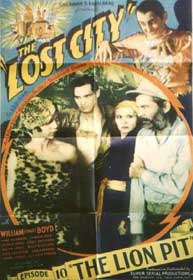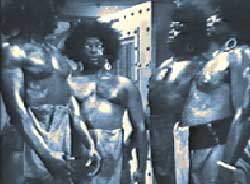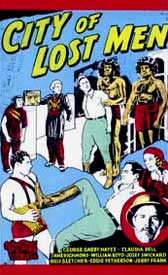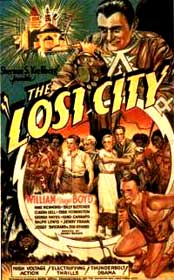 World-wide floods & storms are traced to an origin in Africa. The tracing device was a silly science fiction gizmo that exploded after doing its job.
World-wide floods & storms are traced to an origin in Africa. The tracing device was a silly science fiction gizmo that exploded after doing its job.
So begins the twelve-chapter serial The Lost City (1935). There follows some African jungle adventures surrounding the mystery of Magnetic Mountain, inside which is a weird Land of the Electical Super-Lab, at the heart of a hidden city.
The lab is reluctantly operated by scientific genius Manyus (Josef Swickard) assisted by the Igor-like hunchback Gorzo (William Bletcher) in service of the evil tyrant Zolak (William "Stage" Boyd) the last king of Liguria, an obvious corruption of Lemuria.
Natcha (Claudia Dell) is the damsel in distress, the scientist's captive daughter. Only with her liberty would Manyus rebel against the evil tyrant.
Electricity is used to create an army of the living dead. All the zombies are big & black with huge frizzy afros, even if at the beginning of the process they were small white guys.
 One of the giant black zombies is named Hugo, played by Sam Baker, a black actor whose brief career found him playing the title role in Charles Reisner's silent The Missing Link (1927), plus a handful of standard jungle roles, & the "Yum-yum eatim-up" comedy cannibal of the Our Gang Comedy Washee Ironee (1934).
One of the giant black zombies is named Hugo, played by Sam Baker, a black actor whose brief career found him playing the title role in Charles Reisner's silent The Missing Link (1927), plus a handful of standard jungle roles, & the "Yum-yum eatim-up" comedy cannibal of the Our Gang Comedy Washee Ironee (1934).
It wasn't a very laudible career, his "best" roles being in a couple of Raoul Walsh films, as a muscular swordbearer in Thief of Bagdad (1924) & a laborer in Under Pressure (1935). It's always seemed a great pity to me that black film historians didn't stockpile interviews & biographies for just such bit players, who bravely sought stardom under the worst of prejudiced conditions.
The nephew of Jewish actor Jerry Frank who appears in The Lost City (as Appollon, a cmapy figure widely interpretted as a homosexual figure in girlish bathing suit) reported that his uncle became fast friends with Sam Baker during the filming, & the remained close for the rest of their lives. When they met the Reverand Martin Luther King, Jr., he said that neither of them should be ashamed of the roles they played. I wholeheartedly agree with Martin, & believe this aspect of black history should've been more highly valued as history, even if the majority of the pioneers were not permitted to do uplfiting work.
Sam himself seems never to have overcome the shame of such performances. He was quoted saying of The Lost City: "It would be easy for me to say I needed the money, but I brought embarrassment to my people, & I'm sorry."
 He continued: "But [it] gave me years of work in a white man's world. I got to meet people I would never have even seen in films, because I couldn't have afforded the tickets. And I got to hit the ground running in a new world after the war, & live to see blacks have equality almost everywhere, even in movies. And it helped give my wife and kids a good life when they came along. There's a lot wrong with that film, but out of it, some good came." He continued: "But [it] gave me years of work in a white man's world. I got to meet people I would never have even seen in films, because I couldn't have afforded the tickets. And I got to hit the ground running in a new world after the war, & live to see blacks have equality almost everywhere, even in movies. And it helped give my wife and kids a good life when they came along. There's a lot wrong with that film, but out of it, some good came."
Electrical engineer Bruce Gordon (Kane Richmond in his screen debut) gets a chance to look at the Lost City's technology, & strives to rescue the scientist & his daughter. There's an escape route through the "tunnel of flame" which is an open door with sparklies. There's lots & lots of pointless running around, this being a serial adventure which were notorious for padding, each chapter ending in a cliffhanger.
Each of the separately titled chapters tries to present at least one interesting moment ahead of the cliffhanger. Along the way there'll be many oddities & moments to amuse: A paralyzing ray gun. Evil Arab slave traders led by Sheikh Ben Ali (Gino Corrado) who deduces that the black giants are marketable. There's a giant spider squence very comical, with the spider tribe consisting of little white guys with frizzy white hair.
And there's Queen Rama (Margot D'Use), a bit of a flapper, who wants to become queen of all Africa, a character-type de rigour for "lost city" stories due to the influence of H. Rider Haggard's classic novel She (1887).
 A lot of imagination went into just such matinee serials but they were aimed at children & really never very good. Even so, it's easy to become a fan of such bad stuff, with the right adjustment of expectation. A lot of imagination went into just such matinee serials but they were aimed at children & really never very good. Even so, it's easy to become a fan of such bad stuff, with the right adjustment of expectation.
Most serials were cut down & re-edited as feature films. Generally more than one feature could be derived from the lengthy footage. Parts of this one can be found pared down & re-edited the same year as the release of the full twelve-chapter version, in three different features:
Under the same title The Lost City (1935) there is a 70 minute version derived from the first four chapters. The Lost City of the Ligurians (1935) is made up from fragments of the beginning & the end, leaving out everything to do with the Arab slavers, Queen Rama, & the spider tribe. City of Lost Men (1935) is a 78 minute condensation of the whole serial. A later condensation also titled City of Lost Men (about 1940) was 100 minutes consisting of the first four chapters. The story changes a lot in these varied edits.
copyright © by Paghat the Ratgirl
|

